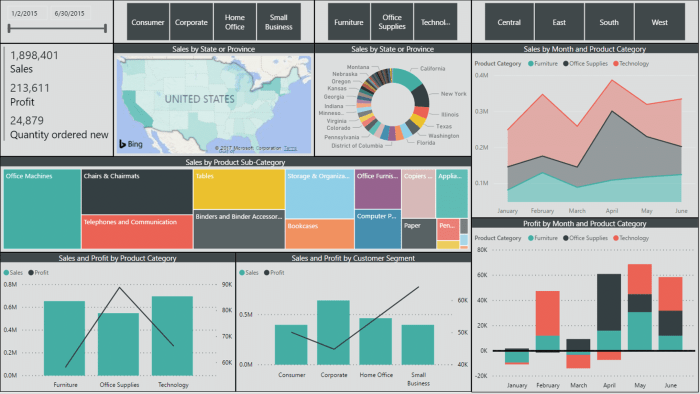Business intelligence software is revolutionizing the way modern enterprises operate by providing critical insights that drive informed decision-making. As businesses navigate an increasingly complex landscape, the importance of harnessing data effectively cannot be overstated. This software not only enables organizations to analyze vast amounts of data but also equips them with the tools necessary to transform that data into actionable strategies.
Over the years, business intelligence software has evolved significantly, incorporating advanced features that streamline processes and enhance operational efficiencies. From basic reporting tools to comprehensive analytics platforms, understanding its core functionalities and the various types available in the market can empower businesses to leverage their data to its fullest potential.
Overview of Business Intelligence Software

Business intelligence (BI) software plays a crucial role in modern enterprises, enabling organizations to analyze data and make informed decisions. This software aggregates, analyzes, and visualizes data to provide actionable insights, which are essential for driving business strategy and improving performance. With the increasing volume of data generated daily, the importance of BI software cannot be overstated as it helps companies navigate the complexities of data management.
Effective business intelligence software is characterized by key features that enhance its usability and effectiveness. These features include data visualization tools, reporting capabilities, real-time analytics, and data mining functionalities. Over the years, BI software has evolved significantly, transitioning from basic reporting tools to comprehensive platforms that incorporate advanced analytics, artificial intelligence, and machine learning capabilities. This evolution reflects the growing need for businesses to harness data for competitive advantage in a rapidly changing market.
Types of Business Intelligence Software

A variety of business intelligence software options are available in the market, each catering to different needs and use cases. The most common types include:
- Self-Service BI Tools: Empower business users to create reports and dashboards without IT assistance.
- Embedded BI: Integrates BI capabilities within other software applications for seamless user experience.
- Cloud-Based BI: Offers scalability and accessibility via cloud technology, ideal for remote work environments.
- On-Premise BI: Provides organizations with complete control over their data and BI applications within their own infrastructure.
A comparative analysis of cloud-based versus on-premise solutions can be illustrated as follows:
| Feature | Cloud-Based BI | On-Premise BI |
|---|---|---|
| Cost | Subscription-based, lower upfront costs | Higher initial investment, ongoing maintenance costs |
| Scalability | Highly scalable with flexible upgrades | Limited scalability; requires hardware upgrades |
| Accessibility | Accessible from anywhere with internet | Limited to local network access |
| Maintenance | Vendor-managed updates and maintenance | Requires in-house IT resources for maintenance |
Popular business intelligence tools such as Tableau, Power BI, and QlikView are widely used for data visualization, reporting, and analytics. These tools allow businesses to derive insights from data, enabling data-driven decision-making processes.
Benefits of Implementing Business Intelligence Software

Utilizing business intelligence software offers numerous advantages that can significantly enhance decision-making processes within organizations. Firstly, these tools facilitate better data visualization, allowing stakeholders to grasp complex datasets quickly and make informed decisions.
Furthermore, BI software can greatly improve operational efficiency by streamlining data access and reporting processes. For example, organizations like Netflix and Amazon have successfully implemented BI solutions to optimize their operations, resulting in enhanced customer experiences and improved revenue.
Challenges and Considerations
While implementing business intelligence software can yield substantial benefits, organizations often face several challenges. Common obstacles include resistance to change from employees, data integration issues, and the need for adequate training.
Data quality and integrity are critical considerations in the success of any BI solution. Poor data quality can lead to misleading insights and, consequently, poor decision-making. Therefore, businesses must prioritize data governance and quality management.
When choosing a business intelligence software, organizations should consider the following key factors:
- Compatibility with existing data sources and systems
- User-friendliness for non-technical users
- Scalability to accommodate future growth
- Vendor support and service level agreements
- Cost versus budget constraints
Integration with Other Systems
Integration plays a vital role in maximizing the effectiveness of business intelligence software. An integrated BI platform can pull data from various sources, providing a holistic view of business performance.
Methods for integrating BI software with existing data sources include using API connections, ETL (Extract, Transform, Load) processes, and direct database connections. These methods ensure that data flows seamlessly into the BI system for real-time analysis.
The following table Artikels popular integration options available for business intelligence tools:
| Integration Option | Description |
|---|---|
| API Integration | Connects BI tools with other applications through application programming interfaces. |
| ETL Processes | Extracts data from various sources, transforms it for analysis, and loads it into the BI system. |
| Database Connections | Directly connects BI tools to databases for live data access. |
Future Trends in Business Intelligence Software
Emerging trends and technologies are shaping the future of business intelligence software. Notably, the integration of artificial intelligence (AI) and machine learning (ML) is revolutionizing data analysis, enabling predictive analytics and deeper insights.
Data visualization advancements are also playing a significant role in the evolution of BI solutions. Enhanced graphical representations of data allow users to identify trends and patterns more effectively, ensuring better decision-making.
Organizations that leverage these technologies will gain a competitive edge in their respective industries, as they will be better equipped to respond to market changes and customer needs.
Closing Summary
In summary, the adoption of business intelligence software offers numerous advantages, from improving operational efficiency to facilitating better decision-making. While challenges such as data quality and integration exist, the future of business intelligence looks promising with emerging trends like artificial intelligence and data visualization. Companies that embrace these technologies stand to gain a competitive edge in their respective industries.
